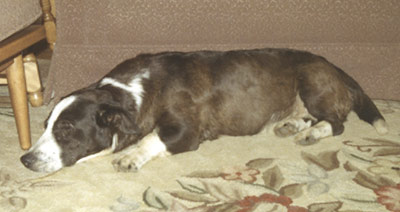One summer in my elementary school years, the dog pictured below charmed my mother and inveigled his way into a cozy sinecure of room and board in our home. This photo is the only record of him.
My mother called him Rufus. He simply wandered in from the street one day, irresistibly friendly and cute in the extraordinary way that only a mutt can be, as a mutt’s DNA is unique, a happy accident. A breeder can offer a collie that at least looks like Lassie, but mutts are one of a kind.

Rufus hung around for a few days, charmed everyone like a politico on the hustings — he could have aced the Sydney Leathers scandal, easily — ate and slept like royalty, and made himself scarce before Mom could think seriously of shots or a dog collar. He simply wandered off, as he had wandered in. We never saw him again. We shared theories about him after he left, and concluded that he likely lived successfully on the bum, by finding a new human to seduce whenever his stomach growled or he wished sleep in a warm room. A canine gigolo.
With one exception, the fictional characters in Brothers of the Milky Way are just that: entirely fictional, conjured out of thin air. The exception is shown above. For all practical intents and purposes, this pooch is Ruby, although Hank’s second chapter description doesn’t entirely jibe with the real life mutt’s particulars.
This is the dog I had in mind when I wrote the first iteration of my novel in 1991. My older self grumbled about any kind of romantic fictionalization of a neglected dog, but the plot depended on Ruby, so back into the story he went, and I once again pictured the dog that had shacked up with us that long-ago summer.
Ladies and gentlemen: Ruby.
My sometimes curmudgeonly present self insists that I add: in real life, one of my saddest memories of teaching in South Los Angeles is of the packs of abandoned dogs I sometimes saw roaming the streets there. They seemed to live off scraps and garbage, and were frequently maimed and murdered in traffic accidents. Not cute or romantic at all.